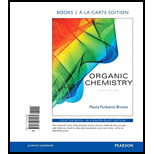
(a)
Interpretation:
Given species has to be rank from best nucleophile to the poorest nucleophile.
Concept Introduction:
Aprotic solvent are polar solvent molecules which do not have hydrogen bonded to oxygen to nitrogen.
Protic solvent are polar solvent molecules which have hydrogen bonded to oxygen to nitrogen.
The stronger base is always a better nucleophile in an aprotic solvent. When the negatively charged species is placed in aprotic solvent, the solvent molecules arrange themselves with their partially positively charged hydrogens pointing towards the negatively charged species. The interaction between the ion and the dipole of the protic solvent is called an ion-dipole interaction
(b)
Interpretation:
Given species has to be rank from best nucleophile to the poorest nucleophile.
Concept Introduction:
Aprotic solvent are polar solvent molecules which do not have hydrogen bonded to oxygen to nitrogen.
The stronger base is always a better nucleophile in an aprotic solvent.
(c)
Interpretation:
Given species has to be rank from best nucleophile to the poorest nucleophile.
Concept Introduction:
Aprotic solvent are polar solvent molecules which do not have hydrogen bonded to oxygen to nitrogen.
Protic solvent are polar solvent molecules which have hydrogen bonded to oxygen to nitrogen
The stronger base is always a better nucleophile in an aprotic solvent. When the negatively charged species is placed in aprotic solvent, the solvent molecules arrange themselves with their partially positively charged hydrogens pointing towards the negatively charged species. The interaction between the ion and the dipole of the protic solvent is called an ion-dipole interaction
(d)
Interpretation:
Given species has to be rank from best nucleophile to the poorest nucleophile.
Concept Introduction:
Aprotic solvent are polar solvent molecules which do not have hydrogen bonded to oxygen to nitrogen.
Protic solvent are polar solvent molecules which do have hydrogen bonded to oxygen to nitrogen
The stronger base is always a better nucleophile in an aprotic solvent.
When the negatively charged species is placed in aprotic solvent, the solvent molecules arrange themselves with their partially positively charged hydrogens pointing towards the negatively charged species. The interaction between the ion and the dipole of the protic solvent is called an ion-dipole interaction.
Want to see the full answer?
Check out a sample textbook solution
Chapter 9 Solutions
Organic Chemistry, Books a la Carte Edition (8th Edition)
- Identify the stronger nucleophile in each pair of anions.a. Br- or Cl- in a polar protic solventb. HO- or Cl- in a polar aprotic solventc. HS- or F- in a polar protic solventarrow_forwardRank the nucleophiles in each group in order of increasing nucleophilicity. а. "ОН, NH, Ha0 b. "OH, Br", F (polar aprotic solvent) c. H20, "OH, CHC0Oarrow_forwardWhich is a better nucleophile? a. Br or C in H20 b. Br or CI in DMSO c. CH3O or CH;OH in H20 d. CH30 or CH3OH in DMSO e. HO or NH2 in H20 f. HO or NH, in DMSO g. F or Br in H20 h. I or Br in DMSOarrow_forward
- Rank the species in each group in order of increasing nucleophilicity.a. CH3CH2S-, CH3CH2O-, CH3CO2- in CH3OHb. CH3NH2, CH3SH, CH3OH in acetonec. -OH, F-, Cl- in acetoned. HS-, F-, Cl- in CH3OHarrow_forwardCan you match best nucleophile / conditions from the list that will give a successful hydrolysis reaction for each electrophile? (there's one best nucleophile / conditions for each electrophile) <List for Nucleophile / condition> a. LiAlH4; hydronium work-up b. PCC c. NaH d. CrO3 e. HOEt f. H3O+ or OH- g. H2O h. NaBH4;hydronium work-up Electrophile 1. Acid chloride 2. Acetic anhydride 3. Ester 4. Amide I'm asking again on bartleby because pther tutor gave me the right answer because I think I didn't make my question clear enough.arrow_forwardCan you match best nucleophile / conditions that will give a successful hydrolysis reaction for each electrophile? 1. Acid chloride 2. Acetic anhydride 3. Ester 4. Amide a. LiAlH4; hydronium work-up b. PCC c. NaH d. CrO3 e. HOEt f. H3O+ or OH- g. H2O h. NaBH4;hydronium work-uparrow_forward
- Identify the stronger nucleophile in each pair of anions. a.Br− or Cl− in a polar protic solvent b.HO− or Cl− in a polar aprotic solvent c.HS− or F− in a polar protic solventarrow_forwardRank the species in each group in order of increasing nucleophilicity. a. CH,, "OH, "NH2 b. H20, OH, "SH in CH3OH c. CH,CH2S", CH;CH2O¯, CH;COO" in CH3OH d. CH3NH2, CH3SH, CH;OH in acetone e. "OH, F", CI" in acetone f. HS, F", CI in CH3OHarrow_forwardRank the species in each group in order of increasing nucleophilicity. a. CH3CH2S−CH3CH2O−, CH3CO2− in CH3OH b. CH3NH2, CH3SH, CHOH in acetone c.−OH, F−, Cl− in acetone d. HS−, F−, Cl− in CH3OHarrow_forward
- Which is a better nucleophile? a. Br− or Cl− in H2O b. Br− or Cl− in DMSO c. CH3O− or CH3OH in H2O d. CH3O− or CH3OH in DMSO e. HO− or −NH2 in H2O f. HO− or −NH2 in DMSO g. I− or Br− in H2O h. I− or Br− in DMSOarrow_forwardThe reaction will proceed with mechanism because the secondary alkyl halide react with nucleophile. + NaOCH3 Br CH3 O a. SN2, strong O b. SN1, strong O c. SN1, weak O d. SN2, weakarrow_forward5. What halide is the strongest nucleophile in a polar aprotic solvent? Why? a. F-, Br-, Cl-, I- b. Br-, H20, TBUOK, CH3NH-arrow_forward
 ChemistryChemistryISBN:9781305957404Author:Steven S. Zumdahl, Susan A. Zumdahl, Donald J. DeCostePublisher:Cengage Learning
ChemistryChemistryISBN:9781305957404Author:Steven S. Zumdahl, Susan A. Zumdahl, Donald J. DeCostePublisher:Cengage Learning ChemistryChemistryISBN:9781259911156Author:Raymond Chang Dr., Jason Overby ProfessorPublisher:McGraw-Hill Education
ChemistryChemistryISBN:9781259911156Author:Raymond Chang Dr., Jason Overby ProfessorPublisher:McGraw-Hill Education Principles of Instrumental AnalysisChemistryISBN:9781305577213Author:Douglas A. Skoog, F. James Holler, Stanley R. CrouchPublisher:Cengage Learning
Principles of Instrumental AnalysisChemistryISBN:9781305577213Author:Douglas A. Skoog, F. James Holler, Stanley R. CrouchPublisher:Cengage Learning Organic ChemistryChemistryISBN:9780078021558Author:Janice Gorzynski Smith Dr.Publisher:McGraw-Hill Education
Organic ChemistryChemistryISBN:9780078021558Author:Janice Gorzynski Smith Dr.Publisher:McGraw-Hill Education Chemistry: Principles and ReactionsChemistryISBN:9781305079373Author:William L. Masterton, Cecile N. HurleyPublisher:Cengage Learning
Chemistry: Principles and ReactionsChemistryISBN:9781305079373Author:William L. Masterton, Cecile N. HurleyPublisher:Cengage Learning Elementary Principles of Chemical Processes, Bind...ChemistryISBN:9781118431221Author:Richard M. Felder, Ronald W. Rousseau, Lisa G. BullardPublisher:WILEY
Elementary Principles of Chemical Processes, Bind...ChemistryISBN:9781118431221Author:Richard M. Felder, Ronald W. Rousseau, Lisa G. BullardPublisher:WILEY





